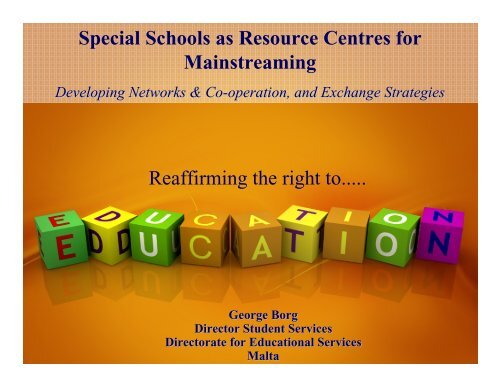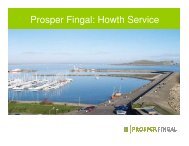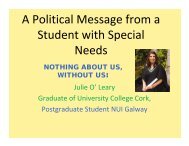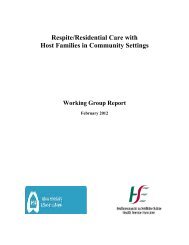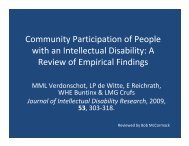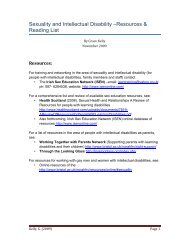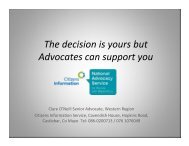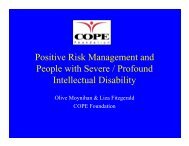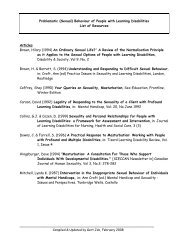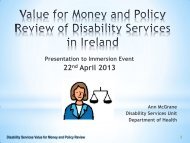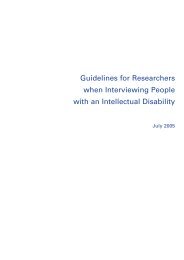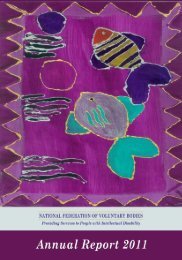Special Schools as Resource Centres for Mainstreaming ...
Special Schools as Resource Centres for Mainstreaming ...
Special Schools as Resource Centres for Mainstreaming ...
Create successful ePaper yourself
Turn your PDF publications into a flip-book with our unique Google optimized e-Paper software.
<strong>Special</strong> <strong>Schools</strong> <strong>as</strong> <strong>Resource</strong> <strong>Centres</strong> <strong>for</strong><br />
<strong>Mainstreaming</strong><br />
Developing Networks & Co-operation, Co operation, and Exchange Strategies<br />
Reaffirming the right to.....<br />
George Borg<br />
Director Student Services<br />
Directorate <strong>for</strong> Educational Services<br />
Malta
Re<strong>for</strong>m of <strong>Special</strong> <strong>Schools</strong> proposed b<strong>as</strong>ed on the following Legislations and<br />
Documents:<br />
o Salamanca Statement (1994)<br />
o Creating Inclusive <strong>Schools</strong> (2002)<br />
o For All Children to Succeed (2005)<br />
o Inclusive and <strong>Special</strong> Education Review (2005)<br />
o Education Act (<strong>as</strong> amended in 2006)<br />
<strong>Special</strong> <strong>Schools</strong> Re<strong>for</strong>m 2009
Rationale of re<strong>for</strong>m:<br />
o To provide quality education with better access to the National<br />
Curriculum to all students.<br />
o To offer specialised services to students in mainstream schools<br />
within the Colleges.<br />
o To offer services, support and training to staff in an inclusive<br />
mainstream setting.<br />
o To act <strong>as</strong> catalysts in the introduction of innovative approaches<br />
to the education of students with individual educational needs.<br />
<strong>Special</strong> <strong>Schools</strong> Re<strong>for</strong>m 2009
Distribution of students with SEN up to the age of 19 years<br />
Mainstream<br />
School<br />
91%<br />
<strong>Special</strong> Cl<strong>as</strong>s<br />
1%<br />
<strong>Special</strong><br />
School<br />
8%<br />
“<strong>Special</strong> pecial schools or units within inclusive schools - may continue to provide the<br />
most suitable education <strong>for</strong> the relatively small number of children child en with disabilities<br />
who cannot be adequately served in n regular cl<strong>as</strong>srooms or schools” schools<br />
p.19
140<br />
120<br />
100<br />
80<br />
60<br />
40<br />
20<br />
0<br />
66<br />
51<br />
122<br />
83<br />
24 20<br />
Students being served in <strong>Special</strong> <strong>Schools</strong><br />
48 44<br />
DMA GA HK SM<br />
1999/2000<br />
2008/2009<br />
Data <strong>for</strong> 2008-2009<br />
includes students till<br />
the age of 22 while in<br />
1999-2000 maximum<br />
age w<strong>as</strong> 19<br />
260<br />
198<br />
“<strong>Special</strong> pecial schools or units within inclusive schools - may continue to provide the<br />
most suitable education <strong>for</strong> the relatively small number of children child en with disabilities<br />
who cannot be adequately served in n regular cl<strong>as</strong>srooms or schools” schools<br />
p.19
140<br />
120<br />
100<br />
80<br />
60<br />
40<br />
20<br />
0<br />
66<br />
36<br />
122<br />
62<br />
24 16<br />
Students being served in <strong>Special</strong> <strong>Schools</strong><br />
48<br />
DMA GA HK SM<br />
36<br />
1999/2000<br />
2008/2009<br />
260<br />
150<br />
“<strong>Special</strong> pecial schools or units within inclusive schools - may continue to provide the<br />
most suitable education <strong>for</strong> the relatively small number of children child en with disabilities<br />
who cannot be adequately served in n regular cl<strong>as</strong>srooms or schools” schools<br />
p.19
Distribution of students (by age) in the <strong>Resource</strong> <strong>Centres</strong><br />
Age SM HK GA DMA<br />
2 0 0 0 0<br />
3 0 0 0 0<br />
4 1 0 0 0<br />
5 1 0 0 0<br />
6 0 0 0 0<br />
7 1 0 0 0<br />
8 5 3 0 0<br />
9 3 1 1 0<br />
10 1 0 1 1<br />
11 1 2 7 0<br />
12 4 2 6 3<br />
Age SM HK GA DMA<br />
13 5 4 11 5<br />
14 3 1 3 5<br />
15 2 0 8 7<br />
16 1 0 5 4<br />
17 4 0 7 3<br />
18 2 1 8 3<br />
19 2 2 5 5<br />
20 2 1 9 4<br />
21 4 2 8 3<br />
22 2 1 4 8<br />
23 0 0 0 0<br />
“<strong>Special</strong> pecial schools or units within inclusive schools - may continue to provide the<br />
most suitable education <strong>for</strong> the relatively small number of children child en with disabilities<br />
who cannot be adequately served in n regular cl<strong>as</strong>srooms or schools” schools<br />
p.19
The Inclusive Curriculum Project<br />
A curriculum project which is<br />
causing a paradigm shift into<br />
appreciating a continuum of<br />
student attainment level that<br />
range from students with the<br />
lowest levels of ability to those<br />
attaining within the range of<br />
students in mainstream<br />
education, this, not being<br />
affected by placement of school<br />
“<strong>Special</strong> schools can provide access to specific devices and materials <strong>as</strong> well <strong>as</strong><br />
training in instructional strategies that are not provided in regular cl<strong>as</strong>srooms” p.35
Rationale of the Inclusive Curriculum Project<br />
oSupport teacher’s professional practice in raising standards of<br />
education <strong>for</strong> ALL students<br />
o Ensure that all students in mainstream schools and resource centres<br />
have access to a common set of subject syllabi thus ensuring equal<br />
opportunities<br />
o Support teachers in achieving these goals through collective critical<br />
self-evaluation<br />
The Inclusive Curriculum Project<br />
“<strong>Special</strong> schools can provide access to specific devices and materials <strong>as</strong> well <strong>as</strong><br />
training in instructional strategies that are not provided in regular cl<strong>as</strong>srooms” p.35
Training provided to special school staff to support students in <strong>Resource</strong> centres and staff in<br />
Mainstream schools:<br />
o Assistive technology training<br />
o Developing AAC strategies <strong>for</strong> students with PMLD<br />
o Supporting Students with Autism Spectrum Disorders<br />
o Keyword signing <strong>for</strong> students with learning disabilities<br />
o Manual signing, story telling and story sharing<br />
o The use of technology and Augmentative and Alternative Means of Communication<br />
o In<strong>for</strong>mation session on PECS<br />
o Objects of reference<br />
o Assessment of students functioning below Level One by using P Scales.<br />
Training Provision<br />
o Curriculum Development in <strong>Special</strong> <strong>Schools</strong> Network through the use of Equals Schemes of Work<br />
“<strong>Special</strong> <strong>Special</strong> schools (<strong>for</strong> those with specific impairments) can represent a<br />
valuable resource <strong>for</strong> the development of inclusive schools.” schools. p.19
Supporting students with SEN who attend mainstream schools<br />
Multi Sensory room : Students receive services in the multi sensory room according to<br />
a pre defined programme which targets their needs. Sessions target an array of<br />
developmental are<strong>as</strong>, including; communication, physical development (fine and gross<br />
motor), sensory stimulation, behaviour management and cognitive development.<br />
ICT room: room Sessions can range from simple switching to more complex scanning<br />
activities and cognitively b<strong>as</strong>ed programmes.<br />
Hydrotherapy Pool:<br />
Hydrotherapy Pool: The hydrotherapy pool is equipped to the requirements of people<br />
with mobility impairments. Adapted showering couches and chairs and transferring<br />
equipment is available. The hydrotherapy pool is used following the Halliwick<br />
swimming system, where techniques are used to enhance mobility, breathing control and<br />
agility in water without using floats.<br />
“Investment in existing special schools should be geared to their new<br />
and expanded role of providing professional support to regular schools<br />
in meeting special educational needs” p.20
Supporting students with SEN who attend mainstream schools<br />
Opti music : is a versatile teaching tool which can target any age appropriate curricular<br />
or non curricular are<strong>as</strong>. Sessions deliver need to be pre programmed and enhance any<br />
learning concept through sensory stimulation, mainly auditory, visual, tactile, gustatory<br />
and olfactory.<br />
Cognitive programme: programme Cognitive programmes delivered on a one to one b<strong>as</strong>is target<br />
individual cognitive levels and needs. Pre curricular activities starting from picture<br />
recognition, <strong>as</strong> well <strong>as</strong> conceptual skills to academical activities involving literacy and<br />
numeracy are carried out.<br />
“Investment in existing special schools should be geared to their new<br />
and expanded role of providing professional support to regular schools<br />
in meeting special educational needs” p.20
Hydrotherapy<br />
pool<br />
Curriculum<br />
ICT<br />
Sensory<br />
circuits<br />
Multisensory<br />
room<br />
Cognitive<br />
programme<br />
Optimusic<br />
Services<br />
“An important contribution to ordinary schools, which the staff of <strong>Special</strong> <strong>Schools</strong><br />
can make, is to the matching of curricular content and method to the<br />
individual needs of pupils” p.19
Thank you<br />
Email: george.a.borg@gov.mt


